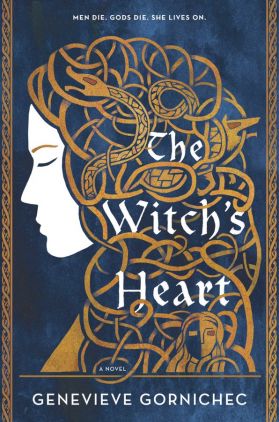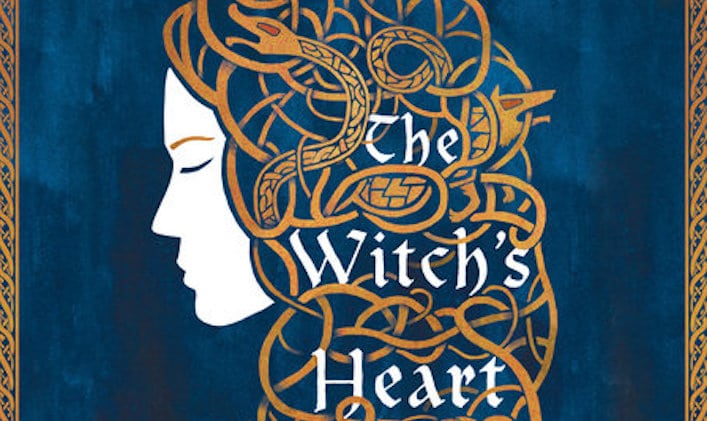There’s one thing that seems to connect a lot of book nerds: a love of mythology. Be it Greco-Roman, Egyptian, Norse, or any and all others, the ancient gods provided a whole different world to play in. In recent years, more and more literature has taken to exploring modern themes in stories of old, especially when it comes to characters that haven’t gotten much of the spotlight. It is in that spirit that The Witch’s Heart hits bookshelves, unraveling the tale of Angrboda.
 For those who didn’t obsess over Norse mythology (or read Neil Gaiman’s recent book on it, which I do recommend), Angrboda is a witch and giant who ends up married to Loki, the trickster god. She bore three children: the wolf Fenrir, the world serpent Jormungand, and the ruler of the underworld Hel. Very little is written about her in the traditional texts, but author Genevieve Gornichec manages to spin a tale of a powerful but lonely woman who has the misfortune of being a seer.
For those who didn’t obsess over Norse mythology (or read Neil Gaiman’s recent book on it, which I do recommend), Angrboda is a witch and giant who ends up married to Loki, the trickster god. She bore three children: the wolf Fenrir, the world serpent Jormungand, and the ruler of the underworld Hel. Very little is written about her in the traditional texts, but author Genevieve Gornichec manages to spin a tale of a powerful but lonely woman who has the misfortune of being a seer.
I will admit that at first, I figured this was going to be sort of in the same vein as Madeline Miller’s hit Circe. After all, both follow a witch who lives in isolation who plays a small, but central part in a larger mythological story and generally involves romance. But let me be clear: The Witch’s Heart is a powerful and heartbreaking story all its own and needs no other influences to stand on.
The main character, Angrboda, is a deeply sympathetic lead. A witch who practices “seid”, the ability to see into the future, she is burnt on a pyre three times by the Aesir, a.k.a the Norse gods led by Odin, and having her heart removed. She flees to Jotunheim, the land of giants, where she is found by Loki, who gives her back her heart. The two fall in love, though Loki often leaves to go antagonize the gods, leaving Angrboda to fend for herself. She meets Skadi, another giantess and hunter, and her cousin Gerd, both of whom come to help and trade with Angrboda throughout the book.
I absolutely adore the depictions of Angrboda’s children, especially Hel. As future queen of the dead, she is her father’s favorite, enamored with his stories of the Aesir. There’s just something about watching this little girl, strange and half-dead as she is, growing up as shy and curious. Her love of her pet goats is particularly sweet as well as serving as tragic foreshadowing of her being cast down into the underworld. Fenrir and Jorgumand don’t get as much development, but that makes sense given they don’t have much to do other than kill gods during Ragnarok.
Gornichec’s portrayal of Loki is also well done. He’s a trickster through and through, and even though it’s made clear how smart he is, he never seems to think things through. He’s sympathetic to a point, and even when you know what’s coming, you almost don’t expect his to betray his family, right up until the moment he does. There’s no questioning the love of his family, but it’s his nature to be chaos and that comes across really well.
The book has spaces where it lags, especially in-between when Jormungand is born and when Angrboda first encounters Loki’s other wife Sigyn, and between Angrboda’s fourth death and her preparations for Ragnarok. However, the parts the come inbetween more than make up for it. The scene where Sigyn and Angrboda meet for the first time, and Angrboda punishes Sigyn with visions of the future after she calls the children “monsters” is visceral. But that’s nothing compared to the scene in which the Aesir come to kill Angrboda and take her children away, which is so heart wrenching and tragic that I couldn’t bear to put it down after that point.
I will say that the romance between Skadi and Angrboda gets hinted at a lot, but doesn’t get quite enough time once they actually express their feelings for one another. Not that this is necessary, but it does feel odd when most of the first half is dedicated to Angrboda’s relationship to Loki. I’m not saying that the whole book had to be about romance, since the focus is on the life of Angrboda, but they are supposed to be together for three years of winter and it goes by in like 10 or 15 pages. I would have liked more development is what I’m saying.
The Witch’s Heart is available for purchase now at any major book retailer.
The Witch’s Heart was provided to us by Berkley Publishing Group. For more information on how we review books and other media/technology, please review our Review Guideline/Scoring Policy.
Summary
The Witch’s Heart takes on the (literal) giants of Norse mythology and manages to make the epic battles and betrayals feel relatable. While it does lag in places and the romance with Skadi could have been elaborated on more, the strong imagery and brisk pace of the rest of the action makes up for it. Angrboda herself is a fascinating character, and one I am glad to have spent such a long time with.


